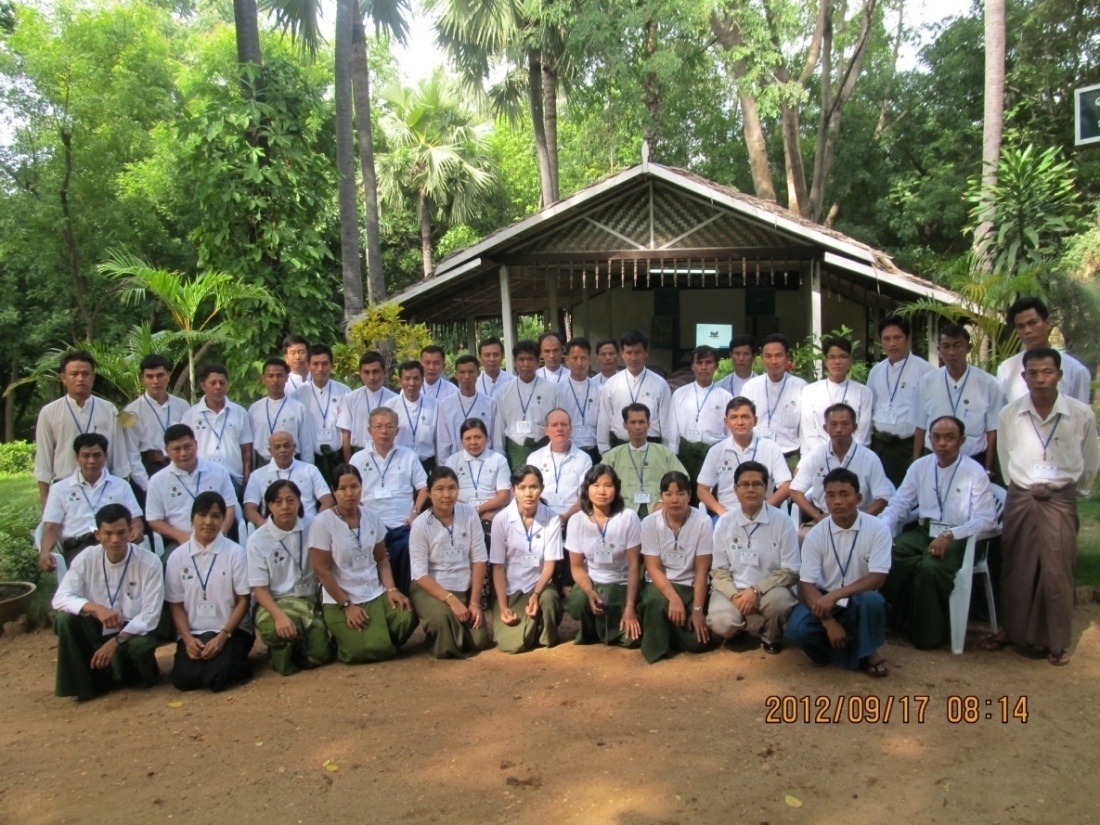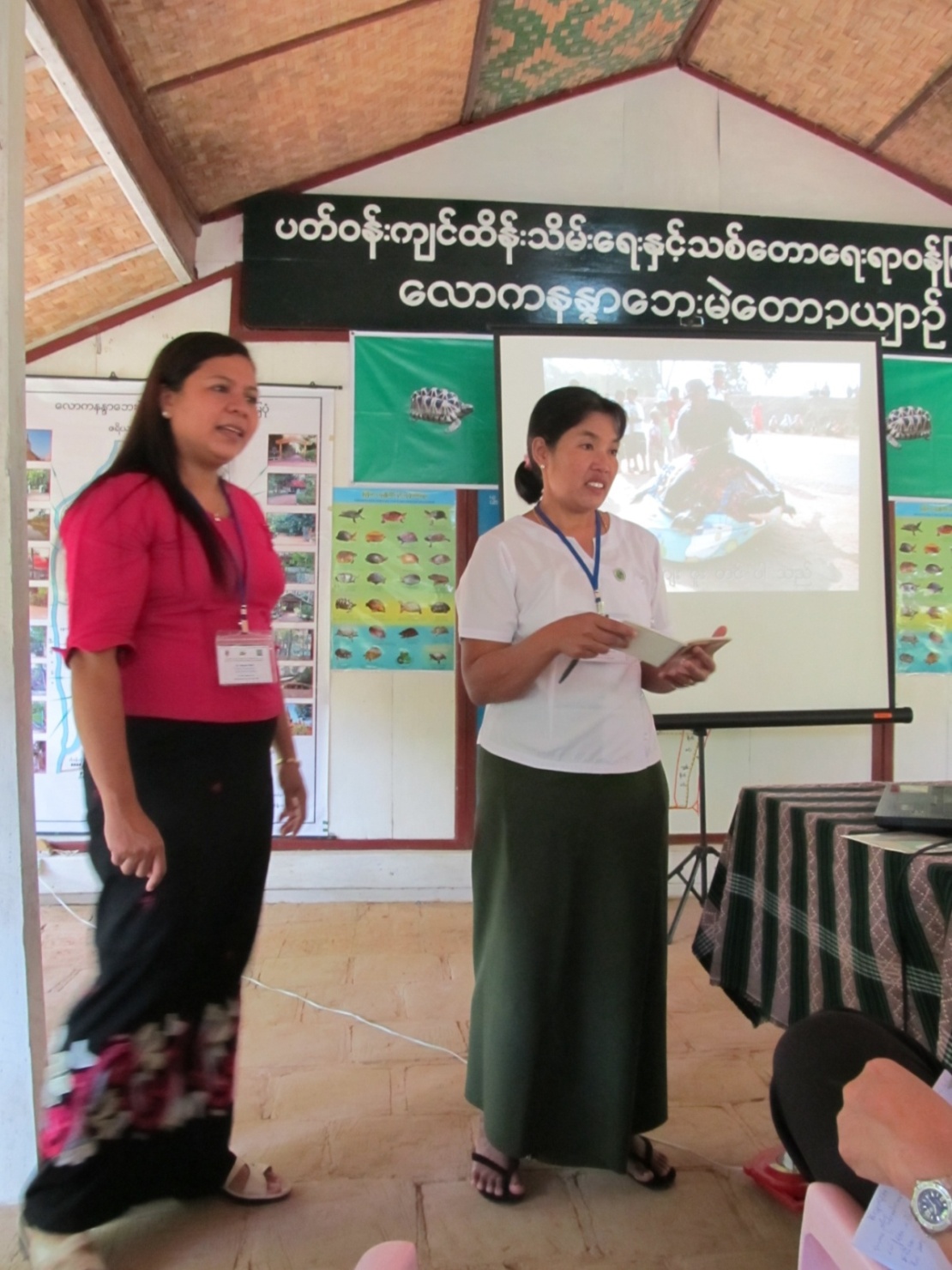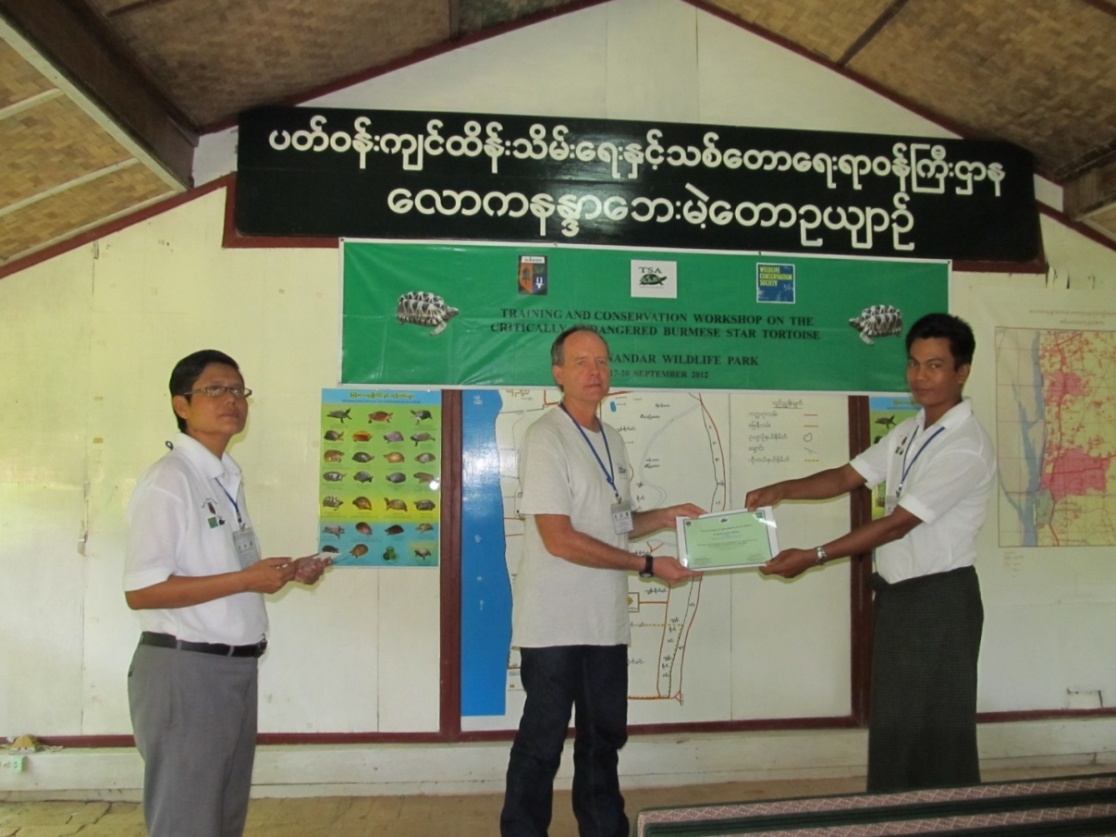Star Tortoise Workshops Hosted in Myanmar
by Steve Platt 
 The Burmese star tortoise (Geochelone platynota) is a Critically Endangered species endemic to the dry zone of central Myanmar. Star tortoises have long been harvested for food by local people, but high demand, first from food and traditional medicine markets in southern China, and later by pet markets in China, Japan, and Thailand led to precipitous population declines during the late 1990s, and the species is now thought to be “ecologically” extinct in the wild. Recognizing that future conservation efforts hinged on developing successful captive breeding programs to supply tortoises for eventual reintroduction, assurance colonies of Burmese star tortoises were established at several facilities in Myanmar (Shwe Settaw, Minzontaung, and Lawkanandar Wildlife Sanctuaries, and Yadanabon Zoological Gardens in Mandalay). To date, these programs have enjoyed considerable success and large numbers of hatchlings are being produced each year. Consequently, the species is now at little risk of biological extinction. Considerable interest has been expressed in reintroducing tortoises into suitably protected sites, and a recent survey identified two wildlife sanctuaries (Shwe Settaw and Minzontaung wildlife sanctuaries) where such projects were deemed feasible.
The Burmese star tortoise (Geochelone platynota) is a Critically Endangered species endemic to the dry zone of central Myanmar. Star tortoises have long been harvested for food by local people, but high demand, first from food and traditional medicine markets in southern China, and later by pet markets in China, Japan, and Thailand led to precipitous population declines during the late 1990s, and the species is now thought to be “ecologically” extinct in the wild. Recognizing that future conservation efforts hinged on developing successful captive breeding programs to supply tortoises for eventual reintroduction, assurance colonies of Burmese star tortoises were established at several facilities in Myanmar (Shwe Settaw, Minzontaung, and Lawkanandar Wildlife Sanctuaries, and Yadanabon Zoological Gardens in Mandalay). To date, these programs have enjoyed considerable success and large numbers of hatchlings are being produced each year. Consequently, the species is now at little risk of biological extinction. Considerable interest has been expressed in reintroducing tortoises into suitably protected sites, and a recent survey identified two wildlife sanctuaries (Shwe Settaw and Minzontaung wildlife sanctuaries) where such projects were deemed feasible.
 As a prelude to reintroduction, a national Burmese star tortoise workshop was conducted at Lawkanandar Wildlife Sanctuary (LWS) from 17 to 21 September 2012 with the following objectives:
As a prelude to reintroduction, a national Burmese star tortoise workshop was conducted at Lawkanandar Wildlife Sanctuary (LWS) from 17 to 21 September 2012 with the following objectives:
1. Conduct a preliminary assessment of the status of wild population of Burmese star tortoises in wildlife sanctuaries and other protected areas of Myanmar.
2. Assess the potential for reintroducing star tortoises in protected areas of Myanmar.
3. Update the status of star tortoise assurance colonies in Myanmar.
4. Assess captive husbandry at assurance colonies and provide recommendations for improvement.
5. Develop a comprehensive conservation action plan for the recovery of star tortoise populations in Myanmar.
Representatives from every assurance colony, zoo veterinarians, and Forest Department staff from wildlife sanctuaries thought to harbor (or formerly harbor) star tortoises were invited to the workshop. Training sessions were conducted by Dr. Steven G.Platt (Wildlife Conservation Society-Myanmar Program), Dr. Kalyar Platt (Turtle Survival Alliance), Dr. Natarika Chansue (Department of Veterinary Medicine, Chulalongkorn University, Bangkok, Thailand), and U Win Ko Ko (Wildlife Conservation Society-Myanmar Program). Each instructor prepared a powerpoint presentation prior to arriving at the workshop and hardcopies were distributed to participants as part of the registration package. Translation of each presentation and discussion was done by Kalyar Platt.
 The anonymous evaluations provided by each participant were extremely complimentary. Without exception, the participants mentioned the excellent translation of each presentation and many stated that although they had attended many training courses in the past, this was the first time they came away with a thorough understanding of the material presented by foreign speakers. We are currently summarizing the results of the workshop and proceedings will be available in the coming months. The initial draft of the document will be prepared in English, circulated among international experts for comment, and then translated into Burmese prior to being distributed in Myanmar.
The anonymous evaluations provided by each participant were extremely complimentary. Without exception, the participants mentioned the excellent translation of each presentation and many stated that although they had attended many training courses in the past, this was the first time they came away with a thorough understanding of the material presented by foreign speakers. We are currently summarizing the results of the workshop and proceedings will be available in the coming months. The initial draft of the document will be prepared in English, circulated among international experts for comment, and then translated into Burmese prior to being distributed in Myanmar.
Acknowledgments
We would like to thank the Minister of the Ministry of Environmental Conservation and Forestry, Director General and Deputy Director General of the Planning and Statistics Department of the Ministry of Environmental Conservation and Forestry, Director General and Deputy Director General of the Forest Department and the Director of NWDC for granting us permission to conduct fieldwork in southern Myanmar. We owe a special debt of gratitude to U Shwe Htay Aung for hosting the workshop at Lawkanandar Wildlife Sanctuary and provided logistical assistance for numerous participants. We owe further gratitude to Assistant Director U Min Htut (Kaw Thaung Town), Assistant Director U Soe Khaing (Myeik Town), Liaison Officer/Staff Officer U Myo Min Naing (Kaw Thaung Town), Staff Officer U Thet Wai (Tanintharyi Town), and all other participating Forest Department staff for their invaluable assistance. U Toe Win Thein is thanked for providing field and logistic assistance in Kaw Thaung. This project was made possible through the generous support of Andy Sabin and the Sabin Family Foundation, Turtle Conservation Fund, and Wildlife Conservation Society. U Than Myint, U Saw Htun, and the WCS Myanmar Program were instrumental in organizing logistics, facilitating fieldwork, and insuring the success of our expedition. Colin Poole, Rick Hudson, Brain Horne, Rob Tizzard, and Lonnie McCaskill are thanked for suggestions and input. We also thank to U Kyaw Thin Latt and U Kyaw Zay Ya (WCS GIS team) for preparing our maps. Thomas Rainwater and Lewis Medlock reviewed an early draft of this report.
